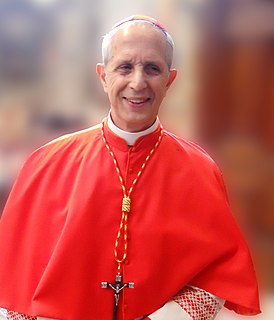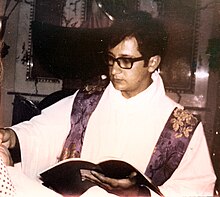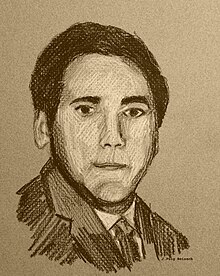
La Rioja is a province of Argentina located in the west of the country. The landscape of the province consist of a series of arid to semi-arid mountain ranges and agricultural valleys in between. It is in one of these valleys that the capital of the province, the city of la La Rioja, lies. Neighboring provinces are from the north clockwise Catamarca, Córdoba, San Luis and San Juan. The dinosaur Riojasaurus is named after the province.

Pope Francis is the head of the Catholic Church and sovereign of the Vatican City State since 2013. Francis is the first pope to be a member of the Society of Jesus, the first from the Americas, the first from the Southern Hemisphere, and the first pope from outside Europe since Gregory III, a Syrian who reigned in the 8th century.

The Society of the Catholic Apostolate, better known as the Pallottines, are a Society of Apostolic Life within the Roman Catholic Church, founded in 1835 by the Roman priest Saint Vincent Pallotti. Pallottines are part of the Union of Catholic Apostolate and are present in 45 countries on six continents. The Pallottines administer one of the largest churches in the world, the Basilica of Our Lady of Peace of Yamoussoukro in Côte d'Ivoire.

Iuliu Hossu was a Romanian Greek-Catholic prelate who served as the Bishop of Cluj-Gherla. Pope Paul VI elevated Hossu to the rank of cardinal in pectore, that is, secretly, in 1969 but did not publish his appointment until after Hossu's death. The Communist authorities arrested Bishop Hossu on 28 October 1948. From 1950 to 1955 he was detained as political prisoner at the Sighet Prison. He spent the rest of his life under house arrest and died in 1970.

Stanley Francis Rother was an American Roman Catholic priest from Oklahoma who was murdered in Guatemala. Ordained a priest for the Archdiocese of Oklahoma City in 1963, he held several parish assignments there until 1968 when he was assigned as a missionary priest to Guatemala, where he was murdered in 1981 inside his mission rectory.

Enrique Ángel Angelelli Carletti was a bishop of the Catholic Church in Argentina who was assassinated during the Dirty War for his involvement with social issues.

The Roman Catholic Diocese of La Rioja is in Argentina and is a suffragan of the Archdiocese of San Juan de Cuyo.
The Martyrs of the Spanish Civil War are the Catholic Church's term for the people killed by Republicans during the Spanish Civil War for their faith. More than 6,800 clergy and religious were killed in the Red Terror. As of June 2022, 2,095 Spanish martyrs have been beatified; 11 of them being canonized. For some 2,000 additional martyrs, the beatification process is underway.

Mamerto Esquiú Medina - born Mamerto de la Ascensión Esquiú - was an Argentine Roman Catholic professed member from the Order of Friars Minor and the Bishop of Córdoba from 1880 until his death.

The 498 Spanish Martyrs were victims of the Spanish Civil War beatified by the Roman Catholic Church in October 2007 by Pope Benedict XVI. It was the greatest numbers of persons ever beatified at once up to that time in the Church's history. They originated from many parts of Spain. Their ages ranged from 16 years to 78 years old. Although almost 500 persons, they are a small part of the Martyrs of the Spanish Civil War.

The San Patricio Church massacre was the mass murder of three priests and two seminarians of the Pallottine order on July 4, 1976, during the Dirty War, at St. Patrick's Church, located in the Belgrano neighborhood in the City of Buenos Aires, Argentina. The victims were priests Alfredo Leaden, Alfredo Kelly, and Pedro Duffau and seminarians Salvador Barbeito and Emilio Barletti. The murders were ordered by Argentine Navy Rear Admiral Ruben Chamorro.

Mario Aurelio Poli is an Argentine prelate of the Catholic Church who has served as the Archbishop of Buenos Aires since April 2013. He previously served as the Bishop of Santa Rosa from 2008 to 2013. Pope Francis, his predecessor in Buenos Aires, made him a cardinal in 2014.

Fabián Edgardo Marcelo Pedacchio Leániz known as Fabián Pedacchio is an Argentine priest of the Catholic Church who served from 2013 to 2019 as a personal secretary of Pope Francis. He works on the staff of the Congregation for Bishops where he worked from 2007 to 2013. Before that, in Argentina, he fulfilled assignments as a parish priest for fifteen years and served on church tribunals at the national level.

Jose Gabriel del Rosario Brochero was a Catholic priest who suffered leprosy throughout his life. He is known for his extensive work with the poor and the sick. He became affectionately known as "the Gaucho priest" and the "cowboy priest".

The Three Martyrs of Chimbote were a group of two Polish Franciscan priests and one Italian missionary priest murdered in Peru in 1991 by the Shining Path communist guerillas. Michał Tomaszek and Zbigniew Adam Strzałkowski, and Alessandro Dordi were murdered on 9 August and 25 August 1991 respectively.

María Antonia de Paz y Figueroa was an Argentinian Roman Catholic nun who later established the Daughters of the Divine Savior. She later became known as "Mama Antula" and took as her religious name "María Antonia of Saint Joseph" upon becoming a professed religious.
Quirico Pignalberi was an Italian Roman Catholic priest and a professed member of the Conventual Franciscans. Pignalberi served as a medic on the frontlines during World War I and served as a novice master and rector of seminarians in the interwar period until the conclusion of World War II when he acted as a sought after confessor and preacher across his region. He was a friend of Saint Maximilian Kolbe and was the last custodian of the late saint's work until his death.
Pedro María Ramírez Ramos was a Colombian Roman Catholic priest killed during the outbreak of the Colombian civil war known as La Violencia. He served as the pastor of Armero, where he was stationed until his murder in 1948. The outbreak of the conflict saw families offer to smuggle him out of the town for his safety, which he refused, saying that he would not abandon his people in their hour of need. But liberal insurgents – who saw him as an instigator of the assassination of a leading national politician – burst into his church and took him to the central square where he was lynched and mutilated.

Pedro Ortiz de Zárate was an Argentine Roman Catholic priest and Giovanni Antonio Solinas was an Italian Roman Catholic priest and a professed member of the Society of Jesus. Zárate served in a local municipal role before he was married and had two children. He was widowed and decided to enter the priesthood once his two sons were old enough to handle the change; he was a noted preacher and envisioned himself as one that would convert and preach amongst the local Argentine native tribes. Solinas left for the Argentine missions alongside three companions and moved from place to place before he settled in the Salta province. Both priests were slain after two tribes of natives decided to deceive them to preach and work in their village before ambushing and killing both priests; eighteen others were slain alongside them and their bodies left to be discovered as the assailants fled in fear of Spanish forces that were not too far from their position.


















